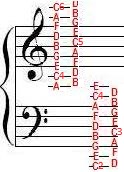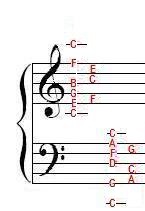Then click on piano-key corresponding to blue note on staff. Learn more





Also, be sure to check out our interactive Circle of Fifths page:
|
Choose scale to practice:
Flute version
Then click on piano-key corresponding to blue note on staff. Learn more | ||
| Score: | Sound | |
 
| ||



|
||
| For something better (albeit without the key signatures) check out the Practice/Notes feature of the free Anvil Studio download, which you can use on your computer or connect to a MIDI keyboard. | ||
Also, be sure to check out our interactive Circle of Fifths page: | ||
Tips
The above image shows all of the notes used on this page, and their corresponding piano keys. The "Grand Staff" consists of a Treble Staff (on top) and the Bass (pronounced Base) Staff on the bottom. Normally, the Treble notes are played with the right hand, and the Bass with the left. The notes A3 - E4 can appear as part of the Treble or Bass Staff, depending on which hand the music arranger wanted the pianist to use. (More notes than these can overlap on a real musical score, but these are the only overlapping notes used on this page.) The notes "flip over" on the middle line of both staves (D3 and B4). This helps identify the middle line of the staves. A full piano keyboard actually has more keys than shown here (extending to the left with octaves 1 and a partial octave 0 (A-B), and to the right with the rest of octave 6, a 7th octave, and a C8 for a total of 88 keys.) Tips for remembering Piano Keys
The above pattern of 12 keys repeats over and over on the keyboard. So, you just need to learn this one pattern of 12 keys. Learn to recognize the groupings of black keys: there is one group of two black keys, and then another group of three black keys. The C key is always to the immediate left of the group of two black keys. The F key is always to the immediate left of the group of three black keys. Knowing your alphabet, and knowing that G is the highest key (so that after G you start again at A), you can easily figure out the other keys. Each key (including the black keys) is a half-step (or "semitone"). The Sharp symbol (#) indicates that the written note should be raised a half-step. So, C# is the black key immediately to the right of the C key. The Flat symbol (b) indicates that the written note should be lowered a half-step. So, Db is the black key immediately to the left of the D key. (Yes, this is the very same key as C#. Every key actually has more than one name.) Sharps and Flats are not necessarily black keys, though that's the only way to refer to the black keys. E#, for instance, is the white F key. Fb is the white E key. And F## (double-sharp) is the white G key. For harmonic-minor keys, where we need to raise the seventh note of the scale, the double-sharp is used for a note that is already sharp in the signature. Conversely, a natural sign is needed before a harmonic-minor seventh note that is flat in the key signature. We'll discuss key signatures in a bit. Tips for remembering Notes on the Grand StaffThe notes on the piano go from left (lower tone) to right (higher tone). But when we write music on the page, we write lower tones lower on the page, and higher tones higher on the page, something like this: The problem with this is that there's not much information here: such as the length of the note, or how it relates to the next note, or how loud or soft to play it. So, instead of using letters, we use "notes": oval objects with or without stems, capable of conveying more of this sort of information. Then, to indicate which "letter notes" they are, we assign them a position and add a grid to make their position clear:
Here is this idea shown on the the Grand Staff (with note names and their octave numbers). 
Each line and space represents a different note (except, of course, for the overlap between the Treble and Bass clefs which can represent the same notes). Going up the staves goes forward through the alphabet one letter at a time (looping at G back to A): 
Going down the staves goes backward through the alphabet one letter at a time: 
You will find it most beneficial to memorize these letters forwards and backwards to the point where you can start with any single letter and go forward or backward without hesitation. Once you have mastered this, you should then skip every other letter: forwards, and then backwards, starting at various points in the series: For instance (starting with E): E, G, B, D, F, A, C, ...E, G, B, D, F, A, C, E, ... E, C, A, F, D, B, G, ...E, C, A, F, D, B, G, E, ... MnemonicsSome people prefer to memorize this series of alternating notes by means of mnemonics: sentences where the first letter of each word matches the pattern. Here are some examples.Going up the staves we have:
Going down the staves we reverse the order:
Examples of use If we know where G is on the Treble staff, and we're trying to figure out what the note is two lines above it, we can go: g,b,d or, to use the mnemonic: Good Boy Deserves, and arrive at D. Or, if we're trying to figure out the note on the bottom line of the Base staff, we can start at F and go: f,d,b,g or, to use the mnemonic method: Frequently Delighted By Grandma, and arrive at G. Using this method, if we need to find out what the note is between two lines, we have to start on a space. For example, if we want to figure out the note three spaces above the G on the Treble staff, we would have to first remember that after G comes A, so A is the space immediately above the G. Then we can go: a,c,e or, to use the mnemonic method: And Cake Every, arriving at E. Visual, Instant Recognition of the NotesEventually, with enough practice, you'll begin to recognize the notes without using the mnemonics. Towards that end, here are some more tips to remembering:One line has been identified for us by the clefs themselves:  The Treble clef, which looks very much like an enormous "G" is curled right around the G line. And the Bass clef, which looks like a fancy curved "f" has its dots just above and below the F line. 
"There is a bed in the middle of the staff room!" Remember the first and last letter of BeD: B is the middle line of the Treble staff, and D is the middle line of the Bass staff. 
E and F are the bottom two notes as well as the top two notes of the Treble Clef. Remember: Edith and Frankie sang Treble. G and A are the bottom two notes as well as the top two notes of the Bass Clef. Remember: Garth and Arlo sang Bass. 
Finally, it's a good idea to remember where all of the C notes are. Notice that between the Treble and Bass staffs they are a mirror image of each other! You now have tips for remembering all of the notes shown below. Filling in the gaps shouldn't be too hard, and before you know it you'll be recognizing the notes by sight, especially if you practice on this page frequently. 
Ledger LinesOnce you're familiar with the treble and bass clefs, here is a way to visualize ledger lines. For ledger lines above the treble clef, visualize a bass clef superimposed on the F line. For ledger lines below the bass clef, visualize a treble clef superimposed on the G line.
Key SignaturesThe key signature is the series of sharps or flats preceding the first bar of music. It indicates which notes will be flat or sharp throughout the piece, unless explicitly overridden. For instance, the key of G Major has one sharp in the key signature: f#. This means that throughout the song you will play f# everytime that you see an f note (unless an "accidental" sign (sharp, flat, natural, double-sharp, or double-flat) preceeds the f note (such accidentals override from the point they appear until the end of the bar in which they appear). There are no sharps or flats in "C" Major, or its related minor key: "a" minor, so there is no visible key signature for these scales.The sharps and flats are always given in the same order in the signature: so if you memorize the following, you will know which sharps or flats are in the signature without having to read each one:
So, if you see 4 sharps in the key signature, you know that they are: F#, C#, G#, D# (Father Charles Goes Down). If you see 3 flats, you know they are: Bb, Eb, Ab (Battle Ends, And). |
|||||||||||||
Back to Top |